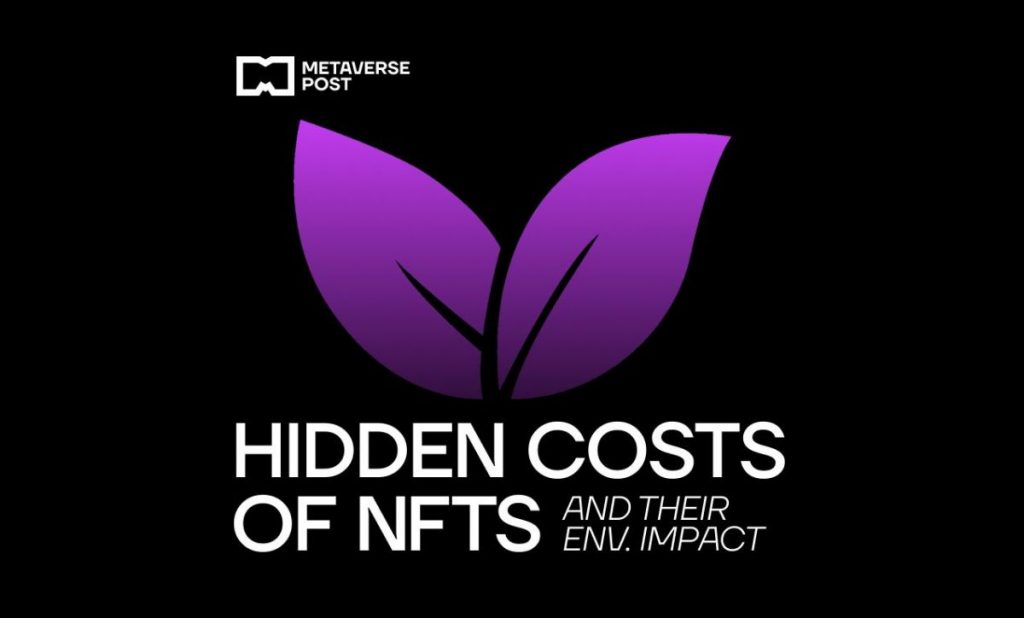Hidden Costs of NFTs: Environmental Impact and Ecological Damage


In Brief
Cryptocurrency and NFTs generate significant greenhouse gas emissions and consume staggering amounts of computing energy
The cost in carbon of mining blockchain has a tremendous impact on the environment when a brand-new NFT is minted
As more and more people become aware of the ecological damage and climate change caused by technological progress, there is increasing concern about the environmental impact of nonfungible tokens or NFTs.

NFTs are digital assets that are stored on a blockchain, which is a decentralized ledger that records all transactions. While NFTs themselves don’t use much energy, the process of mining, or verifying, transactions on a blockchain do. In fact, blockchain systems can be quite an energy intensive.
According to one estimate, the annual electricity consumption of the bitcoin network is about as much as the annual electricity consumption of the country of Argentina. And it’s only going to increase as more people use NFTs and blockchain systems.
The hidden costs of NFTs go beyond their environmental impact. There are also economic costs associated with NFTs, such as the cost of the hardware and software needed to create and store them. Additionally, there are opportunity costs associated with NFTs, as they divert resources away from other uses.
NFTs have become increasingly popular in recent years due to their unique value proposition.

Here are some of the key reasons why NFTs are so valuable:
- NFTs are unique: Unlike fiat currency or other digital assets, each NFT is unique and can’t be replicated. This uniqueness makes NFTs valuable to collectors and investors.
- NFTs are scarce: There is a limited supply of NFTs, which increases their value.
- NFTs are durable: NFTs are stored on a blockchain, which is a decentralized and distributed ledger. This makes them much more durable than other digital assets.
- NFTs are divisible: NFTs can be divided into smaller units, which makes them more liquid and easier to trade.
- NFTs are portable: NFTs can be easily transported and stored.
- NFTs are verifiable: NFTs are stored on a blockchain, which allows for easy verification of their authenticity.
Are NFTs bad for the environment?
The future of blockchain art is bright, but it will take time for all the elements to come together. Julian Hosp, a digital artist known by his pseudonym “Beeple,” sold his work “Everyday: The First 5000 Days” for a staggering $69 million Christie’s bid and believes in a more sustainable future for NFTs.
He thinks he could reduce CO2 emissions from his NFTs by investing some of his money in renewable energy sources, environmental preservation projects, and developing technology that reduces CO2 emissions.
The money donated went to developing blockchain technology so we can hold people accountable for contributing to climate change. The technology will help track the carbon footprint of each NFT and its creators.

It’s a start, but it’s not enough. We need to do more to reduce the environmental impact of NFTs. The solution isn’t to get rid of NFTs; it’s to make them more sustainable.
One way to make NFTs more sustainable is to use renewable energy to power the blockchain systems that they rely on. Another way is to create NFTs that are carbon-neutral or even carbon-negative. And finally, we can develop new technologies that reduce the energy consumption of blockchain systems.
What is the carbon footprint of an NFT?
While it’s somewhat difficult to calculate the carbon footprint of an NFT, we can make some estimates.
According to one study, the annual electricity consumption of the bitcoin network is about as much as the annual electricity consumption of the country of Argentina. If we assume that all NFTs have a similar carbon footprint, then we can estimate that each NFT has a carbon footprint of about 2,000 kg of CO2.
Of course, this is just an estimate. The actual carbon footprint of an NFT will depend on a number of factors, including the type of blockchain that it’s stored on, the electricity mix that powers the blockchain, and the efficiency of the hardware used to create and store the NFT.
Another source of concern for environmental impacts is cryptocurrency mining. Its influence is comparable to that of data centers. While more data has been produced in recent years, particularly in the area of Bitcoin mining, it’s not yet feasible to calculate the entire blockchain technology’s environmental effect due to its use of various indicators, causes, and procedures.
As NFTs become more popular, it’s important to consider their environmental impact. We need to do more to make NFTs sustainable. Otherwise, they could have a negative impact on the environment.
How harmful are the NFTs stored on Ethereum?
NFTs are often stored on Ethereum, which is a blockchain platform. While Ethereum is not as energy-intensive as Bitcoin, it still has a significant environmental impact.
Ethereum’s annual electricity consumption is about as much as the annual electricity consumption of the country of Qatar. If we assume that all NFTs have a similar carbon footprint, then we can estimate that each NFT has a carbon footprint of about 1,000 kg of CO2.

On one hand, if more people create, trade, and store NFTs, then more energy-intensive transactions would have to be generated. As a result of this increase in demand for Ethereum power usage, There would be a rise in carbon emissions. But how much NFTs are actually impacting Ethereum transactions and hurting the environment is no easy answer.
It’s difficult to say how much NFTs are really harming the environment because we don’t know how many people are using them or will use them in the future. It’s also hard to compare the environmental impact of different types of NFTs because they can be stored on different blockchains. Some NFTs might have a smaller environmental impact than others, depending on the blockchain they’re stored on.
Proof-of-Work vs. Proof-of-Stake energy consumption
With blockchain technology, NFT investors can purchase items such as virtual land, in-game assets, and digital art. When an NFT is created, it’s stored on a blockchain, which is a distributed database that’s maintained by a network of computers.
Blockchains use two different types of algorithms to validate transactions: proof-of-work (PoW) and proof-of-stake (PoS). PoW blockchains, such as Bitcoin and Ethereum, use a lot of energy because they require computers to solve complex mathematical problems in order to validate transactions. PoS blockchains, such as EOS and Cardano, don’t require as much energy because they don’t rely on mathematical problems to validate transactions.
If we assume that all NFTs have a similar carbon footprint, then we can estimate that each NFT has a carbon footprint of about 2,000 kg of CO2. But this is just an estimate. The actual carbon footprint of an NFT will depend on a number of factors, including the type of blockchain that it’s stored on, the electricity mix that powers the blockchain, and the efficiency of the hardware used to create and store the NFT.

Another source of concern for environmental impacts is cryptocurrency mining. While more data has been produced in recent years, particularly in the area of Bitcoin mining, it’s not yet feasible to calculate the entire blockchain technology’s environmental effect due to its use of various indicators, causes, and procedures.
NFTs have the potential to revolutionize many different industries, but we need to be aware of their environmental impact. We need to do more to make NFTs sustainable. Otherwise, they could have a negative impact on the environment.
What other steps can be taken to improve NFTs’ carbon footprint?
There are a few things that can be done to reduce the carbon footprint of NFTs:
Use a proof-of-stake blockchain
PoS blockchains are more energy-efficient than PoW blockchains. So, if you’re going to store your NFTs on a blockchain, choose a PoS blockchain.
Use a blockchain with a green energy mix
Some blockchains, such as Ethereum, are powered by a mix of renewable and non-renewable energy sources. Others, such as Bitcoin, are powered mostly by non-renewable energy sources. Choose a blockchain that’s powered by renewables to help reduce the carbon footprint of your NFTs.
Use efficient hardware
The hardware used to create and store NFTs can also impact their carbon footprint. Choose energy-efficient hardware to help reduce the carbon footprint of your NFTs.
Educate yourself and others about the environmental impact of NFTs
The more people know about the environmental impact of NFTs, the more likely they are to take steps to reduce their carbon footprint. Spread the word about the environmental impact of NFTs and how to reduce it.
FAQs
It takes a lot of energy to make NFTs in the way that they are. The proof-of-work operating mechanism, which consumes a lot of electricity, is used to produce the majority of NFTs. Any energy-intensive operation, whether related to cryptography or not, can hasten climate change by increasing carbon dioxide emissions.
The average carbon footprint of a single NFT has been determined to be 211 kg of CO2, which is equal to 1,000 miles of gas-powered travel.
The proof-of-work method is the primary cause of NFTs’ high energy usage. An NFT cannot be tokenized by a single person. Instead, a large number of miners compete simultaneously to confirm the tokenization. Not everyone will succeed, though.
The energy consumption of blockchain transactions like buying and selling NFTs is decreased by around 99% when proof of stake is used instead of proof of work. The two main platforms that employ this type of validation nowadays are Solana and Algorand.
The Ethereum blockchain is where NFTs are most frequently issued; each Ethereum transaction takes about 48 kWh and the proof-of-work consensus mechanism. According to analysts, the typical NFT uses 75 kWh throughout the course of its lifetime (with all transactions taken into account).
Keep track of cryptocurrency distributions in our Airdrops Calendar.
Conclusion
NFTs have the potential to revolutionize many different industries, but we need to be aware of their environmental impact. We need to do more to make NFTs sustainable. Otherwise, they could have a negative impact on the environment. Taking steps to reduce the carbon footprint of NFTs is vital if we want to ensure that they have a positive impact on the world.
Additional NFT resources:
Disclaimer
In line with the Trust Project guidelines, please note that the information provided on this page is not intended to be and should not be interpreted as legal, tax, investment, financial, or any other form of advice. It is important to only invest what you can afford to lose and to seek independent financial advice if you have any doubts. For further information, we suggest referring to the terms and conditions as well as the help and support pages provided by the issuer or advertiser. MetaversePost is committed to accurate, unbiased reporting, but market conditions are subject to change without notice.
About The Author
Damir is the team leader, product manager, and editor at Metaverse Post, covering topics such as AI/ML, AGI, LLMs, Metaverse, and Web3-related fields. His articles attract a massive audience of over a million users every month. He appears to be an expert with 10 years of experience in SEO and digital marketing. Damir has been mentioned in Mashable, Wired, Cointelegraph, The New Yorker, Inside.com, Entrepreneur, BeInCrypto, and other publications. He travels between the UAE, Turkey, Russia, and the CIS as a digital nomad. Damir earned a bachelor's degree in physics, which he believes has given him the critical thinking skills needed to be successful in the ever-changing landscape of the internet.
More articles

Damir is the team leader, product manager, and editor at Metaverse Post, covering topics such as AI/ML, AGI, LLMs, Metaverse, and Web3-related fields. His articles attract a massive audience of over a million users every month. He appears to be an expert with 10 years of experience in SEO and digital marketing. Damir has been mentioned in Mashable, Wired, Cointelegraph, The New Yorker, Inside.com, Entrepreneur, BeInCrypto, and other publications. He travels between the UAE, Turkey, Russia, and the CIS as a digital nomad. Damir earned a bachelor's degree in physics, which he believes has given him the critical thinking skills needed to be successful in the ever-changing landscape of the internet.


















































